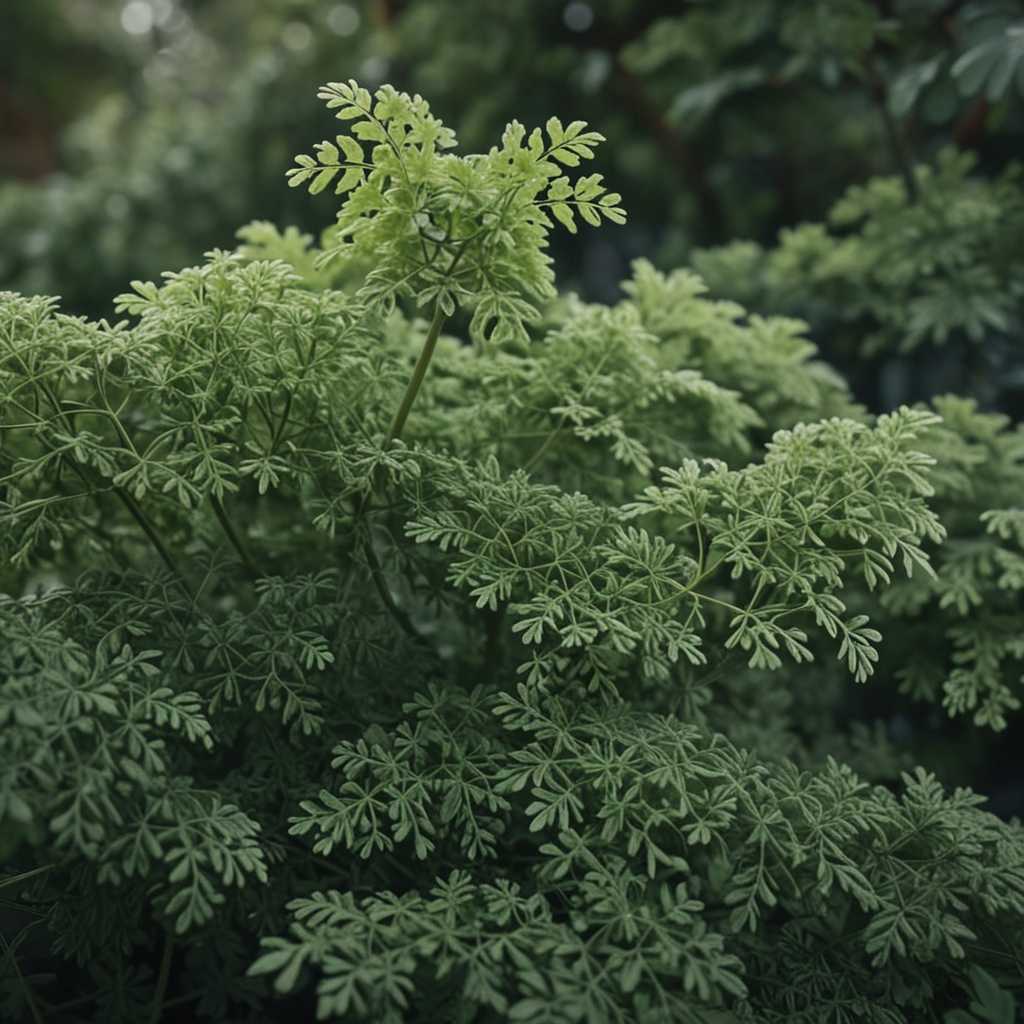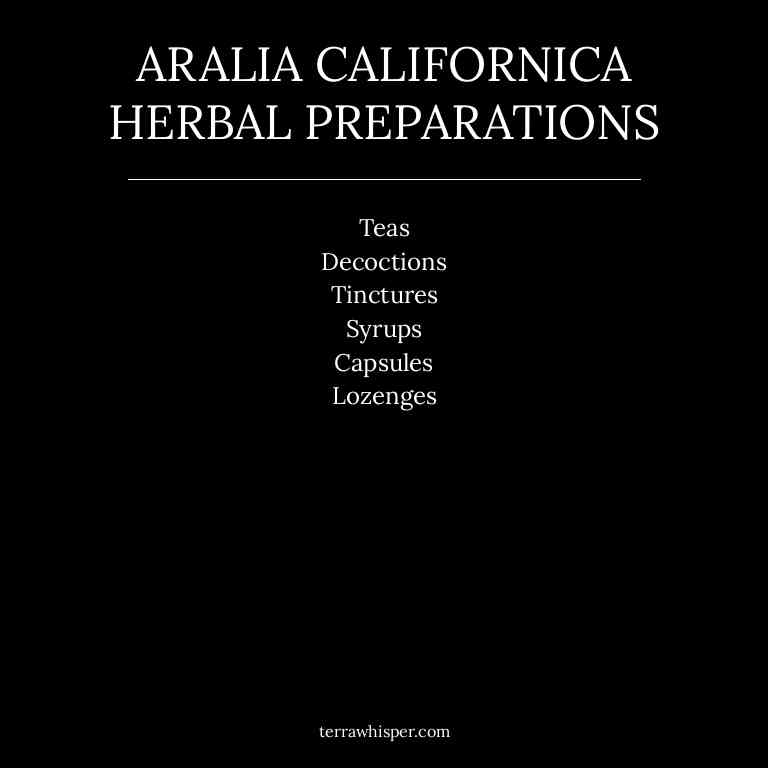Aralia Californica Uses, Benefits, And Remedies

Aralia californica, commonly known as California aralia, is a perennial herb native to the western United States, characterized by its large, compound leaves and clusters of small white flowers.
It is valued for its potential health benefits, including anti-inflammatory, antioxidant, and immune-supporting properties.
The herb contains bioactive constituents such as alkaloids, flavonoids, and saponins, which contribute to its therapeutic actions.
It can be prepared as an infusion, tincture, or powder to harness its medicinal properties.
This page analize the most important medicinal aspects of Aralia californica.
- Health Benefits
- Bioactive Constituents
- Medicinal Parts
- Herbal Preparations
- Side Effects of aralia californica
Health Benefits
Aralia californica eases arthritis pain due to its anti-inflammatory compounds, such as saponins and flavonoids, which help reduce joint inflammation and improve mobility by inhibiting the production of pro-inflammatory cytokines.
It boosts the immune system by containing antioxidants like polyphenols that neutralize free radicals, enhance white blood cell activity, and support the body's natural defense mechanisms. It removes toxins naturally through its detoxifying properties, as it stimulates the liver and kidneys to filter out harmful substances from the bloodstream. It removes heavy metals by binding to these toxins and facilitating their excretion from the body, thanks to its chelating agents that enhance metal ion elimination.
It reduces inflammation quickly because of its high concentration of bioactive compounds that suppress inflammatory pathways and promote cellular repair.
The 10 best health benefits of Aralia californica are shown in the image below.

The list below give a brief description of the 10 best health benefits of Aralia californica.
- Eases Arthritis Pain: Aralia californica contains compounds that help reduce joint inflammation and pain associated with arthritis.
- Boosts Immune System: This herb supports the immune system by enhancing the body's natural defenses against infections and diseases.
- Removes Toxins Naturally: Aralia californica aids in the body's detoxification processes, helping to eliminate harmful toxins from the system.
- Removes Heavy Metals: The herb has properties that assist in the removal of heavy metals from the body, promoting detoxification.
- Reduces Inflammation Quickly: It possesses anti-inflammatory properties that can rapidly reduce inflammation in the body.
- Treats Respiratory Issues: Aralia californica can help alleviate symptoms of respiratory conditions such as coughs and bronchitis.
- Treats Cancer Cells: Some studies suggest that it may have properties that inhibit the growth of cancer cells.
- Reduces Stress Levels: The herb has calming effects that can help reduce stress and promote relaxation.
- Reduces Fever Quickly: Aralia californica can help lower body temperature and reduce fever symptoms rapidly.
- Treats Digestive Issues: It supports digestive health by alleviating issues such as indigestion and bloating.
Bioactive Constituents
Aralia californica flavonoids, such as quercetin, are known for their potent antioxidant and anti-inflammatory properties, which contribute to the plant's traditional use in herbal medicine.
These compounds help neutralize free radicals in the body, potentially reducing oxidative stress and supporting overall cellular health. Quercetin, a specific flavonoid found in Aralia californica, has been studied for its ability to modulate immune responses and may aid in the treatment of inflammatory conditions.
In addition to flavonoids, the herb contains saponins, which are known for their ability to enhance the absorption of nutrients and may have antimicrobial and anti-cancer properties. Phenolic acids present in Aralia californica also contribute to its therapeutic potential by providing additional antioxidant protection and supporting liver function.
Together, these medicinal constituents make Aralia californica a valuable source of natural compounds with a wide range of health benefits.
The 11 best bioactive constituents of Aralia californica are shown in the image below.

The list below give a brief description of the 10 best bioactive constituents of Aralia californica.
- Flavonoids: Flavonoids are a group of plant compounds known for their antioxidant properties, which may help protect cells from damage caused by free radicals.
- Quercetin: Quercetin is a flavonoid with strong antioxidant and anti-inflammatory properties, often used for its potential health benefits.
- Saponins: Saponins are natural compounds found in many plants, known for their ability to lower cholesterol and exhibit antimicrobial properties.
- Phenolic Acids: Phenolic acids are a class of antioxidants that help neutralize free radicals and may reduce the risk of chronic diseases.
- Caffeic Acid: Caffeic acid is a phenolic compound with antioxidant and anti-inflammatory properties, often found in various plant-based foods.
- Ursolic Acid: Ursolic acid is a triterpene with anti-inflammatory, antimicrobial, and potential anticancer properties.
- Terpenoids: Terpenoids are a diverse class of organic compounds found in plants, often responsible for their aromatic properties and various biological activities.
- Rosmarinic Acid: Rosmarinic acid is a phenolic acid with antioxidant, anti-inflammatory, and antimicrobial properties, commonly found in herbs like rosemary.
- Tannins: Tannins are a type of polyphenol that can bind to proteins and have astringent properties, often used for their antimicrobial and antioxidant effects.
- Fatty Acids: Fatty acids are essential components of cell membranes and play a crucial role in energy storage and signaling processes in the body.
- Glycosides: Glycosides are compounds composed of a sugar molecule bonded to another compound, often exhibiting various pharmacological activities such as cardiovascular and anti-inflammatory effects.
Medicinal Parts
Aralia californica leaf has been traditionally used in herbal medicine for its potential therapeutic properties.
The leaves contain various bioactive compounds, including alkaloids, flavonoids, and saponins, which may contribute to its medicinal value. In some indigenous and traditional practices, the leaves have been applied externally to treat skin conditions and inflammation. The leaf's ability to reduce swelling and promote healing has made it a subject of interest in modern herbal research.
While more studies are needed to confirm its efficacy, the leaf remains a valued component in the herbal use of Aralia californica.
Herbal Preparations
Aralia californica teas are commonly prepared by steeping the dried roots or leaves in hot water, offering a mild, earthy flavor that is often used for its purported calming and digestive benefits.
Decoctions, which involve boiling the root for a longer period, are preferred for extracting more potent compounds and are believed to support respiratory and immune health. Tinctures made from Aralia californica are concentrated liquid extracts, typically used for their potential anti-inflammatory and adaptogenic properties, and are often taken in small doses. Syrups made from the herb are sometimes used as a soothing remedy for coughs or sore throats, though they should be used with caution due to the potential toxicity of the plant.
Capsules and lozenges provide a convenient form for regular use, though it is important to consult a healthcare professional before using any preparation of Aralia californica, as it can be toxic in high doses.
The 10 best herbal preparations of Aralia californica are shown in the image below.

The list below give a brief description of the 10 best herbal preparations of Aralia californica.
- Teas: Aralia californica tea is used to support respiratory health, reduce inflammation, and promote digestion due to its mild expectorant and antispasmodic properties.
- Decoctions: Aralia californica decoctions are prepared by simmering the root and are used to address digestive issues, respiratory conditions, and as a general tonic for overall wellness.
- Tinctures: Aralia californica tinctures are concentrated extracts used to support immune function, alleviate respiratory symptoms, and promote circulation due to their potent medicinal properties.
- Syrups: Aralia californica syrups are often used to soothe coughs, relieve throat irritation, and support respiratory health due to their expectorant and soothing effects.
- Capsules: Aralia californica capsules offer a convenient way to consume the herb for its immune-boosting, anti-inflammatory, and digestive benefits.
- Lozenges: Aralia californica lozenges are used to relieve sore throats, reduce coughing, and provide a soothing effect on the respiratory tract.
Side Effects of aralia californica
Aralia californica causes skin irritation, often manifesting as redness, itching, or a rash upon contact with the plant's sap or leaves.
This reaction is due to the presence of urushiol, a compound also found in poison ivy, which can trigger an inflammatory response in sensitive individuals. In addition to skin irritation, the herb may lead to gastrointestinal upset, including nausea, vomiting, and stomach cramps, particularly if ingested.
Some people may experience headaches or respiratory issues after exposure, suggesting a broader systemic reaction. Eye irritation is also possible if the plant's sap comes into contact with the eyes, potentially causing discomfort or redness.
These side effects highlight the importance of handling Aralia californica with care and avoiding direct contact or ingestion to prevent adverse health effects.
The 9 most common side effects of Aralia californica are shown in the image below.

The list below give a brief description of the 9 most common side effects of Aralia californica.
- Causes Skin Irritation: Contact with the skin may lead to redness, itching, or rash due to the presence of irritant compounds in the plant.
- Triggers Allergic Reactions: Some individuals may experience allergic responses such as hives, swelling, or difficulty breathing upon exposure to the herb.
- Leads To Nausea: Ingestion of Aralia californica may cause feelings of sickness or an upset stomach in some people.
- Induces Gastrointestinal Upset: The herb can irritate the digestive system, leading to discomfort, bloating, or a general feeling of being unwell.
- May Cause Vomiting: Consuming the herb can result in vomiting as the body attempts to expel the substance.
- Leads To Stomach Cramps: The herb may cause spasms or cramping in the stomach area due to its irritant properties.
- Triggers Respiratory Issues: Inhalation of the herb's pollen or dust may cause coughing, wheezing, or shortness of breath in sensitive individuals.
- May Cause Eye Irritation: Contact with the eyes can lead to redness, burning, or excessive tearing due to the herb's irritating compounds.
- Leads To Headaches: Some people may experience headaches as a side effect of exposure to the herb, possibly due to its chemical composition.